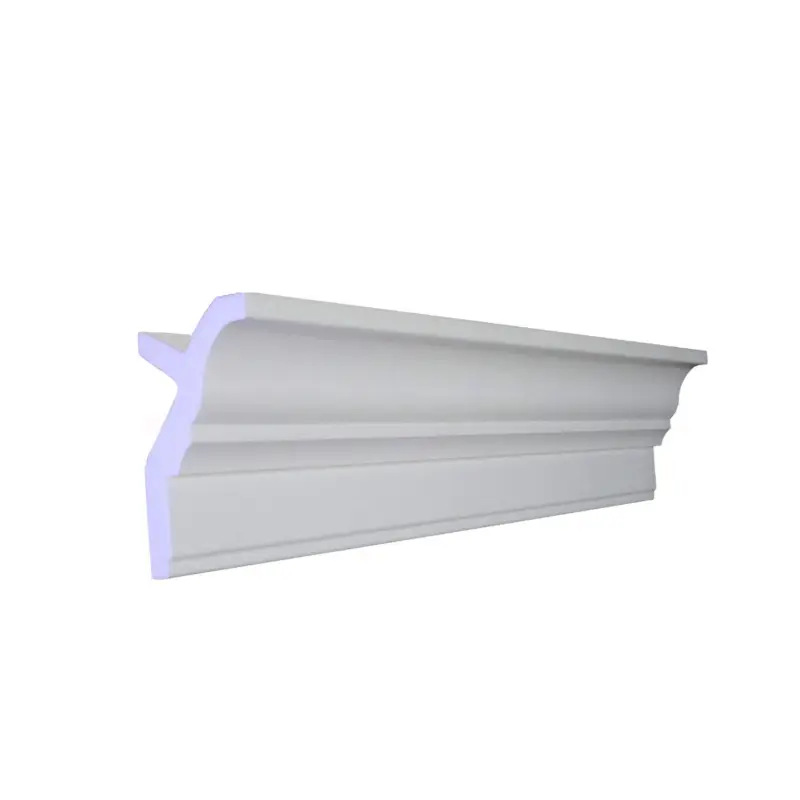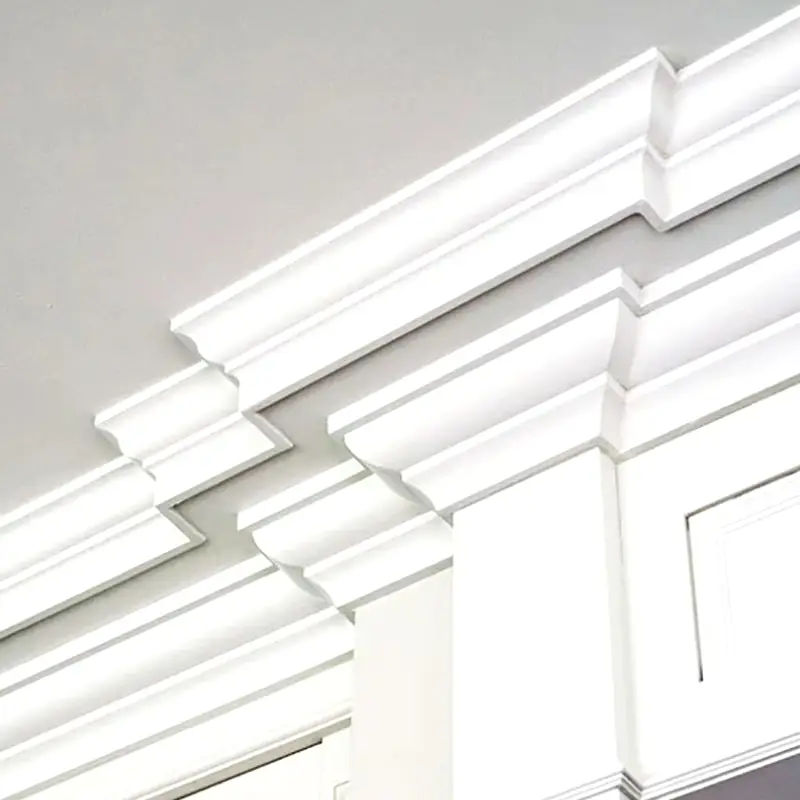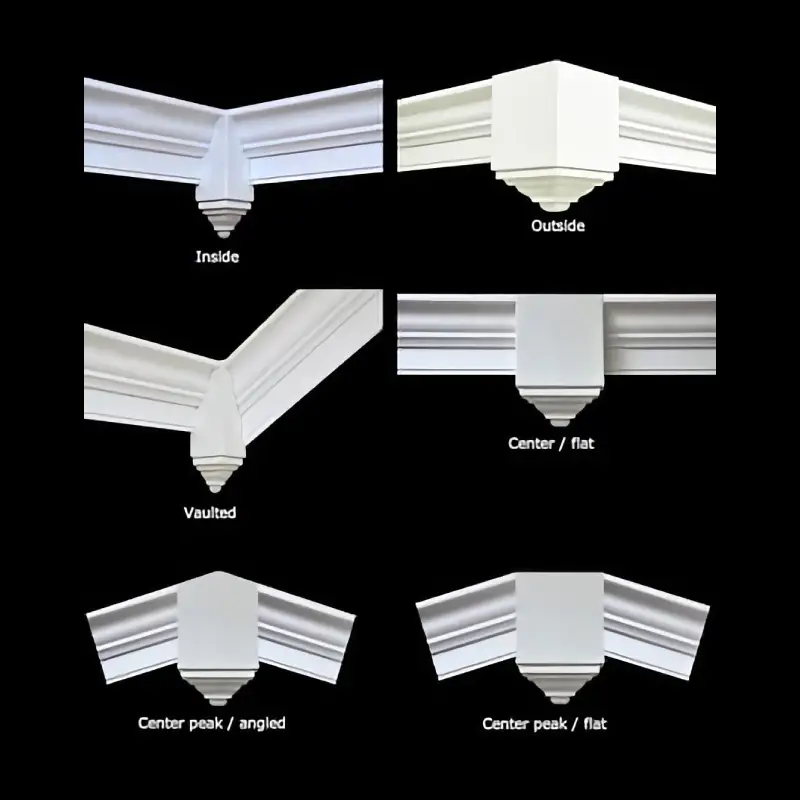
Styrofoam Crown Molding
Transform your space with our affordable and lightweight Styrofoam crown molding. It’s easy for DIYers to install, won’t warp or crack, and is a simple way to add a sophisticated touch to any room. Available in a variety of classic and modern styles, our molding is a cost-effective solution for a quick home upgrade.
Get Styrofoam Crown Molding Wholesale

Cost-Effective: Styrofoam crown molding is significantly more affordable than wood or plaster, making it a great option for those on a budget.
Lightweight and Easy to Install: Its light weight makes it easy for a single person to handle and install without the need for special equipment. It can be cut with a simple saw or utility knife and attached with construction adhesive, saving on labor costs and time.
Moisture Resistant: Unlike wood, Styrofoam is impervious to moisture, making it ideal for high-humidity areas like bathrooms, kitchens, and basements where warping and rot are a concern.
Durable and Crack-Resistant: It’s less likely to crack or chip during installation or from house settling, offering long-lasting beauty.
Environmentally Friendly: Many Styrofoam products are made from recycled materials, and their energy-efficient production process has a lower environmental impact compared to some other materials.
Different Styrofoam Crown Molding shapes
Inside Corner: This shape is used to connect two pieces of crown molding at an interior corner where two walls meet. It provides a seamless transition and a finished look.
Outside Corner: This piece is designed for exterior corners, such as around a chimney breast or the edge of a wall. It creates a clean, professional finish on an outer angle.
Vaulted Corner: This specialized piece is used to connect crown molding on a vaulted or cathedral ceiling. It is engineered to handle the steep angle where the wall meets the sloped ceiling.
Center / flat: This type of piece, often called a “center block” or “end block,” is used on a flat ceiling to provide a decorative transition point or to cap off a run of molding. It can be used for aesthetic purposes or to simplify the cutting process at a seam.
Center peak / angled: This molding piece is designed for a central peak on a vaulted or angled ceiling. It serves as a decorative focal point and is cut to fit the specific angle of the ceiling slope.
Center peak / flat: This is similar to the angled center peak but is used for a flat ceiling, often at the highest point of a room’s design. It provides a distinct decorative element in the center of the ceiling.

FAQs about ETPU Shoe Sole Mould
how to install styrofoam crown molding?
Installing Styrofoam crown molding is a straightforward DIY project that can dramatically enhance the look of a room. This guide will walk you through the simple steps to achieve a professional-looking finish.
Step 1: Prepare the Area and Materials
Before you begin, ensure the walls and ceiling are clean and dry. Gather your tools: a miter saw or utility knife, a caulking gun, construction adhesive, and a measuring tape. It’s also wise to have a pencil for marking and a level.
Step 2: Measure and Cut the Molding
Measure the length of each wall where the molding will be installed. Use a miter saw to cut the molding to the correct lengths and angles, typically 45-degree angles for inside and outside corners. Dry-fit the pieces before applying any adhesive.
Step 3: Apply Adhesive and Install
Apply a bead of construction adhesive to the back of the molding where it will meet the wall and ceiling. Press the molding firmly into place, wiping away any excess adhesive immediately. Use painter’s tape to hold the molding in position while the adhesive cures.
Step 4: Finishing Touches
Once the adhesive has cured, remove the painter’s tape. Use a flexible caulk to fill in any gaps between the molding and the wall or ceiling, as well as at the seams where pieces meet. This creates a seamless, professional finish.
where to use styrofoam crown moulding?
Styrofoam crown molding is a versatile and practical choice for many areas in a home or commercial building. Its key benefits, like moisture resistance and light weight, make it suitable for places where traditional wood molding might be a challenge.
Bathrooms and Kitchens: The moisture-resistant properties of Styrofoam make it perfect for rooms with high humidity and temperature fluctuations, preventing the warping and damage common with wood.
Basements and Laundry Rooms: These areas are often prone to dampness. Styrofoam molding is an excellent choice as it won’t rot or grow mold, ensuring a lasting, clean look.
DIY Projects: Its ease of installation, requiring minimal tools and no special skills, makes it ideal for homeowners looking to add architectural detail to bedrooms, living rooms, and hallways without hiring a professional.
Uneven Surfaces: Styrofoam molding can flex slightly, allowing it to conform better to slightly uneven walls or ceilings, which is often an issue in older homes.
Commercial Spaces: For offices or retail spaces with suspended ceilings or metal stud walls, Styrofoam molding can be easily glued to the walls, providing an elegant finish where nailing is not an option.
styrofoam crown moulding advantages
Styrofoam crown molding has become a popular alternative to traditional materials due to its numerous advantages. It is exceptionally lightweight, making it easy to transport, handle, and install by a single person, which significantly reduces labor costs and the need for specialized tools. Its affordability is another major benefit, as it is much less expensive than wood or plaster molding.
Cost-Effective: Styrofoam is a budget-friendly option that allows homeowners to achieve an elegant look without a significant financial investment.
Easy Installation: Its light weight and ability to be cut with a simple utility knife or miter saw make it a perfect DIY project. It adheres to surfaces with construction adhesive, eliminating the need for nails or screws.
Moisture and Pest Resistant: Unlike wood, Styrofoam does not rot, warp, or absorb moisture, making it an ideal choice for high-humidity areas like bathrooms and kitchens. It is also impervious to termites and other common household pests.
Durability: Styrofoam molding is resistant to cracking and chipping, a common problem with plaster molding, and it can flex to conform to slightly uneven walls and ceilings.
Versatile Design: It comes in a wide array of styles and can be easily painted with water-based paint to match any color scheme, offering great flexibility in design.
how to manufacture styrofoam crown moulding?
The manufacturing of Styrofoam crown molding is a multi-step process that transforms raw polystyrene beads into the finished product. Here is a general overview of the process:
Raw Material Preparation: The process begins with small, hard polystyrene beads, which are a petroleum-based plastic. These beads are combined with a blowing agent, typically pentane, which is what allows them to expand.
Pre-Expansion: The polystyrene beads are then exposed to steam in a pre-expander machine. The steam heats the beads, causing the blowing agent to activate and the beads to expand significantly, sometimes up to 50 times their original size. This step is crucial for achieving the lightweight, foam-like structure. The density of the final product can be controlled at this stage by adjusting the amount of steam and the expansion time.
Molding: The expanded beads are then transferred to a mold that is the exact shape of the desired crown molding profile. Steam is again introduced into the mold, which causes the beads to fuse together and fill the entire cavity. The heat and pressure solidify the material into a single, cohesive piece.
Cooling and Shaping: After the molding process, the Styrofoam is cooled to ensure it retains its shape and dimensional stability. Once cooled, the large blocks or pieces of molded foam are often cut into the final lengths and sizes using hot wire cutters or specialized saws.
Finishing (Optional but common): Some Styrofoam crown moldings are sold as-is, while others may receive an additional finishing layer. This can include a hard, flexible coating of plaster or other proprietary materials that gives the molding a smoother, more durable surface. This finishing layer can also make the molding more resistant to scratches and impact, and it provides a better surface for painting.
